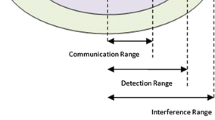Abstract
Vehicular Ad-Hoc Networks (VANETs) are susceptible to various types of attacks due to their characteristics. Among these threats, greedy behaviour attacks stand out, necessitating the update and adaptation of security measures to mitigate this evolving threat. While much of the existing literature on greedy behaviour attacks has focused on the CSMA/CD protocol, this paper shifts its focus to the Time Division Multiple Access (TDMA) protocol, specifically the Distributed Time Division Multiple Access (DTMAC) protocol. The aim is to uncover potential greedy actions that attackers could exploit. We carefully analyze the DTMAC protocol and identify four new greedy actions, revealing new vulnerabilities that have not been explored before. To prevent these newly discovered behaviours, we implement a new watchdog system that utilises fuzzy logic. This watchdog system acts as a robust defense mechanism, actively identifying potential attackers who display greedy actions within the DTMAC protocol. Extensive simulations using NS2 were carried out for validation and evaluation purposes. The outcomes of our experiments show outstanding performance metrics such as accuracy, precision, recall, and F1 score. These results highlight the effectiveness of our suggested watchdog-based method in identifying greedy behaviour attackers in the DTMAC protocol.













Similar content being viewed by others
Data availability
Data sharing is not applicable to this article as no datasets were generated or analyzed during the current study.
References
Hadded M, Laouiti A, Zagrouba R, Mühlethaler P, Saidane LA. A fully distributed TDMA based MAC protocol for vehicular ad hoc networks. Ph.D. thesis, Inria Paris Rocquencourt; 2015.
Tambawal AB, et al. Time division multiple access scheduling strategies for emerging vehicular ad hoc network medium access control protocols: a survey. Telecommun Syst. 2019;70:595–616.
Rebei A, Hadded M, Touati H, Boukhalfa F, Muhlethaler P. MAC-aware routing protocols for vehicular ad hoc networks: a survey. 2010; pp. 1–6
Baccari S, Touati H, Hadded M, Muhlethaler P. Performance impact analysis of security attacks on cross-layer routing protocols in vehicular ad hoc networks. IEEE;2020. pp. 1–6.
Baccari S, Hadded M, Touati H, Muhlethaler P. A secure trust-aware cross-layer routing protocol for vehicular ad hoc networks. 2020.
Mokdad L, Ben-Othman J, Nguyen AT. DJAVAN: detecting jamming attacks in vehicle ad hoc networks. Perform Eval. 2015;87:47–59.
Tang J, Cheng Y, Hao Y, Zhou C. Real-time detection of selfish behavior in IEEE 802.11 wireless networks. IEEE; 2010. pp. 1–5.
Ismail T, et al. Impact analysis of greedy behavior attacks in vehicular ad hoc networks. IEEE; 2021. pp. 1–6.
Raya M, Aad I, Hubaux J-P, El Fawal A. DOMINO: setecting mac layer greedy behavior in IEEE 802.11 hotspots. IEEE Trans Mob Comput. 2006;5:1691–705.
Hamieh A, Ben-Othman J, Gueroui A, Naït-Abdesselam F. Detecting greedy behaviors by linear correlation in wireless ad hoc networks. 2009.
Tiwary ON. Detection of misbehaviour at mac layer in wireless networks. Proc Int J Sci Eng Res 2012; 3.
Mejri MN, Ben-Othman J. Detecting greedy behavior by linear regression and watchdog in vehicular ad hoc networks. IEEE; 2014. pp. 5032–5037.
Mejri MN, Ben-Othman J. GDVAN: a new greedy behavior attack detection algorithm for VANETs. IEEE Trans Mob Comput. 2016;16:759–71.
Hayajneh T, Almashaqbeh G, Ullah S. A green approach for selfish misbehavior detection in 802.11-based wireless networks. Mob Netw Appl. 2015;20:623–35.
Al-Terri D, Otrok H, Barada H, Al-Qutayri M, Al Hammadi Y. Cooperative based tit-for-tat strategies to retaliate against greedy behavior in VANETs. Comput Commun. 2017;104:108–18.
Hadded M, Muhlethaler P, Laouiti A LA. TDMA-aware routing protocol for multi-hop communications in vehicular ad hoc networks. IEEE; 2017. pp. 1–6.
Mendel JM. Fuzzy logic systems for engineering: a tutorial. Proc IEEE. 1995;83:345–77.
Masdari M, Khezri H. Towards fuzzy anomaly detection-based security: a comprehensive review. Fuzzy Optim Decis Mak. 2021;20:1–49.
Messabih H, Kerrache CA, Cheriguene Y, Calafate CT, Bousbaa FZ. An overview of game theory approaches for mobile ad-hoc networks’ security. IEEE Access. 2023;11:107581–604.
Boualouache A, Engel T. A survey on machine learning-based misbehavior detection systems for 5G and beyond vehicular networks. IEEE Commun Surv Tutor. 2023;25:1128–72.
Sultana R, Grover J, Meghwal J, Tripathi M. Exploiting machine learning and deep learning models for misbehavior detection in VANET. Int J Comput Appl. 2022;44:1024–38.
Ghaleb FA, Saeed F, Alkhammash EH, Alghamdi NS, Al-Rimy BAS. A fuzzy-based context-aware misbehavior detecting scheme for detecting rogue nodes in vehicular ad hoc network. Sensors. 2022;22:2810.
Bai Y, Wang D. Fundamentals of fuzzy logic control-fuzzy sets, fuzzy rules and defuzzifications. In: Advanced fuzzy logic technologies in industrial applications. London: Springer; 2006. p. 17–36.
Issariyakul T, Hossain E, Issariyakul T, Hossain E. Introduction to network simulator 2 (NS2). New York: Springer; 2009.
Karnadi FK, Mo ZH, Lan K-C. Rapid generation of realistic mobility models for VANET. IEEE; 2007. pp. 2506–2511.
Hadded M, Muhlethaler P, Laouiti A, Azzouz Saidane L. A novel angle-based clustering algorithm for vehicular ad hoc networks. Singapore: Springer; 2017. p. 27–38.
Funding
Not applicable.
Author information
Authors and Affiliations
Corresponding author
Ethics declarations
Conflict of interest
The authors declare no conflict of interest.
Ethical approval
This article does not contain any studies with human participants or animals performed by any of the authors.
Additional information
Publisher's Note
Springer Nature remains neutral with regard to jurisdictional claims in published maps and institutional affiliations.
Rights and permissions
Springer Nature or its licensor (e.g. a society or other partner) holds exclusive rights to this article under a publishing agreement with the author(s) or other rightsholder(s); author self-archiving of the accepted manuscript version of this article is solely governed by the terms of such publishing agreement and applicable law.
About this article
Cite this article
Ismail, T., Hajlaoui, N., Touati, H. et al. A Fuzzy-Based Greedy Behaviour Attack Detection Approach in VANETs. SN COMPUT. SCI. 5, 822 (2024). https://doi.org/10.1007/s42979-024-03177-6
Received:
Accepted:
Published:
DOI: https://doi.org/10.1007/s42979-024-03177-6




